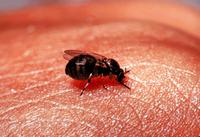Improved Simulium capture for onchocerciasis surveillance
Human exposure risk to onchocerciasis can only be partly described by measuring entomological indices at blackfly breeding sites, where most of the entomological surveillance has taken/takes place, but where only a proportion of the at-risk human population is found. As some vector species have been found at up to 40 km from breeding sites it is therefore also necessary to survey blackflies at various distances from breeding sites, as well as across finer spatial scales within village settings.
The aim of this project is to support vector biting rate modelling in onchocerciasis transmission models by providing more accurate and up-to-date field-derived data on variations in exposure driven by blackfly biting, parity, and infection rates across different spatial scales. The project also aims to calibrate new blackfly sampling methods to give confidence in their uptake at programmatic levels to enhance elimination surveillance and Stop MDA survey quality.
The results will respond directly to stakeholder needs and support onchocerciasis surveillance and intervention programmes by filling in important gaps in our understanding of the entomological components of transmission dynamics away from breeding sites.
Partners are: Greenwich University, Imperial College, Sightsavers (Benin) and University of Energy and Natural Resources (Ghana)


